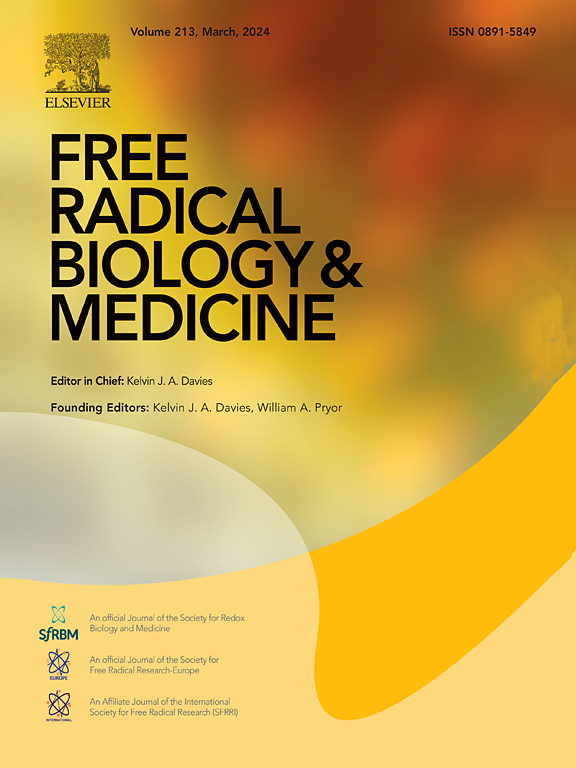虫草素通过激活CacyBP/SIP促进α-突触核蛋白的自噬降解,改善帕金森病的嗅觉功能障碍
IF 7.1
2区 生物学
Q1 BIOCHEMISTRY & MOLECULAR BIOLOGY
引用次数: 0
摘要
嗅觉功能障碍是帕金森病(PD)最早的非运动症状之一,伴有嗅球(OB) α-突触核蛋白聚集异常。我们之前报道了虫草素(Cor),一种潜在的抗炎和抗氧化腺苷衍生物,已经成为帕金森病治疗的一个有吸引力的候选者。然而,现有的研究主要集中在改善运动症状,而不是从前驱期调节疾病进程。本研究旨在评估Cor是否在暴露于鱼烯酮的8周龄雄性C57BL/6小鼠出现运动缺陷前的前驱期发挥疾病改善作用。我们的研究结果表明,给药可显著减轻嗅觉功能障碍并延缓运动障碍的发生。这种治疗效果伴随着OB的病理性α-突触核蛋白聚集体降解。RNA测序分析显示OB的自噬-溶酶体途径(ALP)可能与Cor在PD中的神经保护作用有关。此外,在鱼tenone处理的SH-SY5Y细胞中,Cor通过抑制其泛素蛋白酶体降解,显著稳定了钙素结合蛋白/ siah1相互作用蛋白(CacyBP/SIP)。这种稳定性抑制了NLRP3炎性体的激活,随后增强了自噬体与溶酶体的融合,最终导致α-突触核蛋白的自噬降解。值得注意的是,阻断CacyBP/SIP可消除Cor对鱼藤酮引起的嗅觉损伤的神经保护作用。综上所述,这些发现提示CacyBP/SIP-NLRP3-α-synuclein轴可能是Cor在PD早期治疗中的关键靶点,这为Cor抗PD作用的机制提供了新的见解。本文章由计算机程序翻译,如有差异,请以英文原文为准。

Cordycepin promotes autophagic degradation of α-synuclein via CacyBP/SIP activation for ameliorating olfactory dysfunction against Parkinson's disease
Olfactory dysfunction is one of the earliest non-motor symptoms of Parkinson's disease (PD), accompanied by abnormal α-synuclein aggregation in the olfactory bulb (OB). We previously reported that Cordycepin (Cor), a potential anti-inflammatory and anti-oxidative adenosine derivative, has emerged as an attractive candidate for PD treatment. However, existing investigations have predominantly focused on the amelioration of motor symptoms rather than modulating the disease course from prodromal stage. This study aimed to evaluate if Cor exerts a disease-modifying effect at the prodromal stage prior to the onset of motor deficits in eight-week-old male C57BL/6 mice exposed to rotenone. Our results showed that Cor administration significantly attenuated olfactory dysfunction and delayed the onset of motor impairments. This therapeutic effect was concomitant with pathological α-synuclein aggregates degradation in OB. RNA sequencing analyses revealed that Autophagy-lysosomal pathway (ALP) in OB may be associated with the neuroprotective actions of Cor in PD. Furthermore, Cor significantly stabilized Calcyclin-binding protein/Siah1-interacting protein (CacyBP/SIP) via inhibiting its ubiquitin-proteasome degradation in rotenone-treated SH-SY5Y cells. This stabilization suppressed NLRP3 inflammasome activation and subsequently enhanced autophagosome-lysosome fusion, culminating in the autophagic degradation of α-synuclein. Notably, blockade of CacyBP/SIP abrogated the neuroprotective effects of Cor against rotenone-induced olfactory impairment. Collectively, these findings suggest CacyBP/SIP-NLRP3-α-synuclein axis may serve as a key target of Cor in the early treatment of PD, which provides novel insights into the mechanisms for the anti-PD effect of Cor.
求助全文
通过发布文献求助,成功后即可免费获取论文全文。
去求助
来源期刊

Free Radical Biology and Medicine
医学-内分泌学与代谢
CiteScore
14.00
自引率
4.10%
发文量
850
审稿时长
22 days
期刊介绍:
Free Radical Biology and Medicine is a leading journal in the field of redox biology, which is the study of the role of reactive oxygen species (ROS) and other oxidizing agents in biological systems. The journal serves as a premier forum for publishing innovative and groundbreaking research that explores the redox biology of health and disease, covering a wide range of topics and disciplines. Free Radical Biology and Medicine also commissions Special Issues that highlight recent advances in both basic and clinical research, with a particular emphasis on the mechanisms underlying altered metabolism and redox signaling. These Special Issues aim to provide a focused platform for the latest research in the field, fostering collaboration and knowledge exchange among researchers and clinicians.
 求助内容:
求助内容: 应助结果提醒方式:
应助结果提醒方式:


